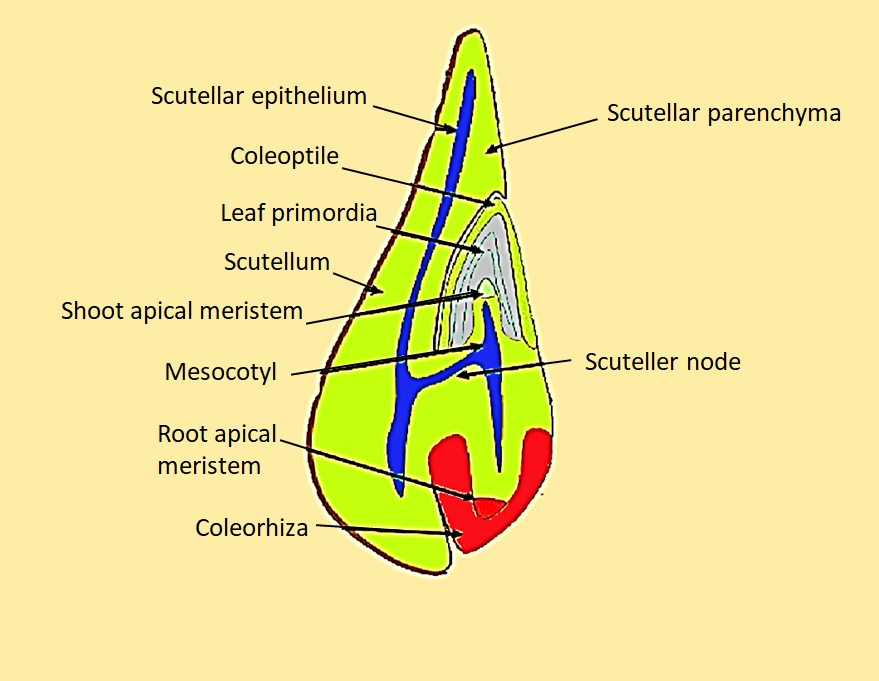
Cotyledons of maize grain is called as
(a) Plumule
(b) Coleorhiza
(c) Coleoptile
(d) Scutellum
Answer
480.6k+ views
Hint: A modified cotyledon present in maize is a large, shield- shaped structure and helps in the absorption of nutrients from the endosperm. These are commonly present in monocotyledon seed.
Complete answer:
In the seeds of maize, the embryo is small and is located in a groove at one end of the endosperm. It consists of one large and shield- shaped cotyledon known as Scutellum and a short axis with a Plumule (represent the future shoot) and radicle (future roots) . Scutellum absorbs the nutrients from the endosperm of the seed and thus, plays an important role is the nourishment of the seedling. The plumule is enclosed in sheaths called coleoptile and the radicle is enclosed in a sheath known as coleorhiza. The seed coat is membranous and generally fused with the fruit wall. The endosperm and embryo are present below the grain covering. The endosperm is bulky and stores food.

Figure: Scutellum of maize
So, the answer is, ‘Scutellum’.
Additional Information: - Monocots are marked by seeds with single cotyledons with parallel venation on leaves and adventitious roots. - Monocot lacks cambium and unlike dicot, these plants grow from inside. - Monocot tends to grow into a herbaceous plant. They grow quickly and stay soft and pliable except for bamboo.
Note: - The scutellum is a believer to be a protein transporter that facilitates starch movement from the endosperm to the embryo. - Scutellum arises from octant cells which also give rise to the cotyledon. - Monocots are the plants that sprout a single leaf from their seeds during germination.
Complete answer:
In the seeds of maize, the embryo is small and is located in a groove at one end of the endosperm. It consists of one large and shield- shaped cotyledon known as Scutellum and a short axis with a Plumule (represent the future shoot) and radicle (future roots) . Scutellum absorbs the nutrients from the endosperm of the seed and thus, plays an important role is the nourishment of the seedling. The plumule is enclosed in sheaths called coleoptile and the radicle is enclosed in a sheath known as coleorhiza. The seed coat is membranous and generally fused with the fruit wall. The endosperm and embryo are present below the grain covering. The endosperm is bulky and stores food.

Figure: Scutellum of maize
So, the answer is, ‘Scutellum’.
Additional Information: - Monocots are marked by seeds with single cotyledons with parallel venation on leaves and adventitious roots. - Monocot lacks cambium and unlike dicot, these plants grow from inside. - Monocot tends to grow into a herbaceous plant. They grow quickly and stay soft and pliable except for bamboo.
Note: - The scutellum is a believer to be a protein transporter that facilitates starch movement from the endosperm to the embryo. - Scutellum arises from octant cells which also give rise to the cotyledon. - Monocots are the plants that sprout a single leaf from their seeds during germination.
Recently Updated Pages
Master Class 11 Accountancy: Engaging Questions & Answers for Success

Glucose when reduced with HI and red Phosphorus gives class 11 chemistry CBSE

The highest possible oxidation states of Uranium and class 11 chemistry CBSE

Find the value of x if the mode of the following data class 11 maths CBSE

Which of the following can be used in the Friedel Crafts class 11 chemistry CBSE

A sphere of mass 40 kg is attracted by a second sphere class 11 physics CBSE

Trending doubts
10 examples of friction in our daily life

Difference Between Prokaryotic Cells and Eukaryotic Cells

State and prove Bernoullis theorem class 11 physics CBSE

What organs are located on the left side of your body class 11 biology CBSE

Define least count of vernier callipers How do you class 11 physics CBSE

The combining capacity of an element is known as i class 11 chemistry CBSE




